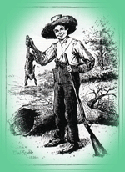|
|
|
|
|
|
|
|
|
|
|
|
|
|
|
|
|
|
|
|
 |
|
|
 |
|
 |
|
|
|
|
|
|
|
|
|
|
CONTENTS
HOME
ABOUT
THIS SITE
TOWARDS
DIGITAL STORYTELLING FOR CHILDREN
THE
EVOLUTION OF STORYTELLING FROM THE MIDDLE AGES
1990'S:
A DIGITAL ENVIRONMENT
TOWARDS
DIGITAL STORYTELLING
BIBLIOGRAPHY
Links
Links will be provided for
key words and ideas in the essay. They are marked with an asterisk in the text
but can only be accessed from the link column.
Alice
in Wonderland
The Adventures of Huckleberry
Finn
|
|
|
|
|
|
|
|
|
|
|
|
|
1800's:
Storytelling that Delights
By
the mid-to late-1800's writers appeared who wrote solely for the
delight and entertainment of children. European and American attitudes towards
children had changed and the puritanical resistance to works of the imagination
fell away before a deluge of entertaining adventures and fantasies written purely
to give pleasure to children and without a shred of moral or lesson.
|
|
|
|
|
|
|
|
|
|
|
|
 |
|
|
|
|
|
|
|
Lewis
Carroll is
credited with the first "fantasy" in his tale Alice in Wonderland. He and other
writers such as Edward Lear wrote stories in which no moral preaching existed,
only odder and odder adventures and situations. Treasure Island was the epitome
of a new genre of action-filled adventure. As a writer, Robert Louis Stephenson
believed that his stories should "absorb and delight [the reader], fill their
minds with a kaleidoscope of images, and satisfy their nameless longings" (Norton
61). (Think of what these visionary and adventurous writers could have done with
digital technology.) |
|
|
|
|
|
|
|
|
|
|
|
|
|
|
|
|
|
|
|
|
|
Fantasy
and adventure
were followed by the development of the science fiction story Twenty Thousand
Leagues under the Sea, local-color stories such as The Adventures of Huckleberry
Finn, stories from foreign lands, and many other new types of narrative which
developed from the cultural changes which were going on at the time. Children's
narrative had finally come into its own and the end of the 19th and beginning
of the 20th century were seen by many as The Golden Age of Children's Literature. |
|
|
|
|
 |
|
|
|
|
|
|
|
|
|
|
|
|
|
|
|
|
|
 |
 |
 |
 |
 |
 |
 |
 |
 |
 |
 |
 |
 |




